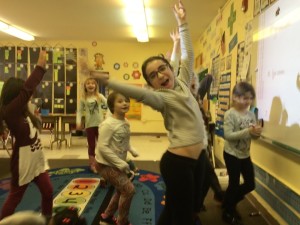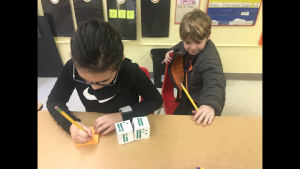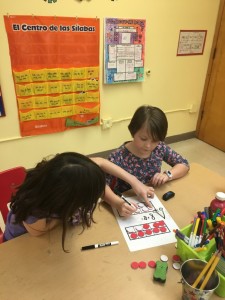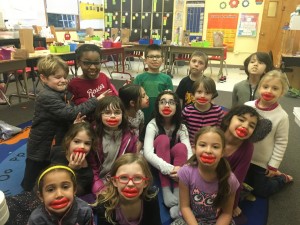
The kiddos reached 2000 tallies for their fantastic use of Spanish in class! They received teeth or lips as part of their piñata.
Literatura
This week we read a great story: Adivina quiên. This is a story about the different community workers in our town and their jobs. This created a great opportunity for us to make lists of the different jobs of our parents. We worked on our classifying and categorizing strategy by dividing our jobs lists into inside or outside jobs.
Our learning objectives this week were to:
- Spell and use the following sight words correctly: porqué/ why, quién/who, juego/ I play or game, cierra/close
- Focus on the correct pronunciation and spelling of güe, güi, gue, gui, ge, gi through reading and dictation.
- Focus on the correct pronunciation and spelling of : /s/ en ci and ce words, and words written with X or Z.
- Plan the writing of an invitation. (You’ll be receiving an invitation this week!)
- Categorize things based on a common factor.
- Identifying words that should be capitalized and words that should not.
Matemáticas
This week we completed our 7th math unit. Students took an assessment on identifying greatest and least in a group. They ordered groups of numbers from least to greatest and greatest to least.
We also began our new math unit: Addition and Subtraction Facts to 20.
Our objectives were to:
- used different strategies to add1- and 2- digit numbers.
-
add by making a 10, using number bonds. (This often looks convoluted and confusing to parents but it is a strategy many of use mentally. This lesson was to show how it is done on paper, to make this strategy accessible to those students who don’t automatically do this mentally.)
Here is a video to help you understand the strategy we introduced on Friday.
History & Geography
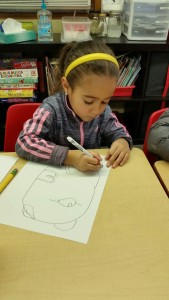 This week in our Early American Civilization unit we continued to read about the Maya and began to learn about the Aztec civilization. They heard the legend of the Eagle and the Serpent. We found the Yucatan Peninsula on the map. The class had fun drawing some Maya glyphs.
This week in our Early American Civilization unit we continued to read about the Maya and began to learn about the Aztec civilization. They heard the legend of the Eagle and the Serpent. We found the Yucatan Peninsula on the map. The class had fun drawing some Maya glyphs.
Our objectives this week were to:
• locate the areas that the Maya and Aztec lived on a map
• understand that the Maya developed large cities of population centers in the rainforests of Mexico and Central America many, many years ago
• describe the significance of the stars and planets to the Maya
• understand that the Maya had a religion
• understand the significance of the Mayan calendar
• understand that the Aztec established a vast Empire in central Mexico many, many years ago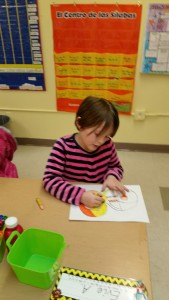
• understand that the Aztec had a religion
Science
This this week in our science unit on matter we talked began to talk about gas. The students did investigations to identify two types of gas and their characteristics.
Our objectives this week were to: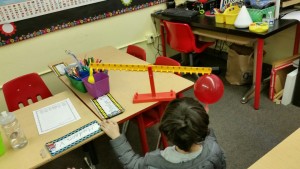
• understand there are three forms of matter; solid, liquid, or gas
• identify characteristics of matter
• identify different examples of gases
• understand that gas occupies space
• observe various gases and describe their characteristics
English Word Work
Our word wall words this week were: most, much, know, knew, I’m
Our vocabulary words for the week were: atoms, accurate, gas, helium, legend, awe, scouts, valley
In spelling on Friday every one got new sorts. The red group worked on l, k, j, w, the blue group is working on consonant blends pr, tr, dr, the green group is working on a and i vowel words with initial blends.
For writing we wrote about the Aztec legend of the Eagle and the Serpent. We also wrote a writing response to our gas investigation this week.
Specialists
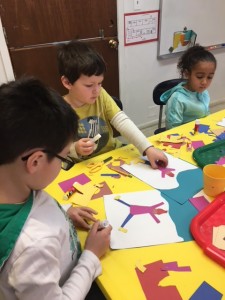 In early January we looked at Ezra Jack Keats’ book “The Snowy Day” and also the US Postal Service stamps honoring this book.
In early January we looked at Ezra Jack Keats’ book “The Snowy Day” and also the US Postal Service stamps honoring this book.
The students learned how to create a figure using basic shapes: They cut out construction paper shapes to make a picture of a child making a snow angel, just like Peter does in “The Snowy Day.”
Then they added boots, mittens, a hat, and an oil pastel shadow.
The following week, we read another Ezra Jack Keats book called “A Letter to Amy” which features Peter in a rain coat. The students made another figure using basic shapes, and also used basic shapes for the sidewalk and buildings. The students did a great job on these “weather” pictures! Looking for basic shapes is a good way to learn how to draw whether it is a person, a landscape, still life, or any object.
We then switched to learning a few facts about Pacific Northwest Native Americans, and how important salmon fishing is to these tribes. We looked at several pictures of salmon swimming upstream to spawn, and the tools that Native Americans used to catch the fish.
The students learned how to draw a Sockeye Salmon using diagonal and curvy lines, then they added color using the side of oil pastels. The students also used the side of white oil pastels to fill in the background. The last step was painting watercolor over their oil pastel drawings. This created some beautiful texture on the fish and in the water. These beautiful fish look like they’re really jumping up a waterfall!
On January 31 and February 7, I will be out of town, and our art substitute Miss Karen will be providing some wonderful lessons on Native American pottery, using real clay and glazes! It would be helpful for the students to bring a clean plastic container (from salad mix or berries, etc.) to transport their clay pieces home when they’re finished.

